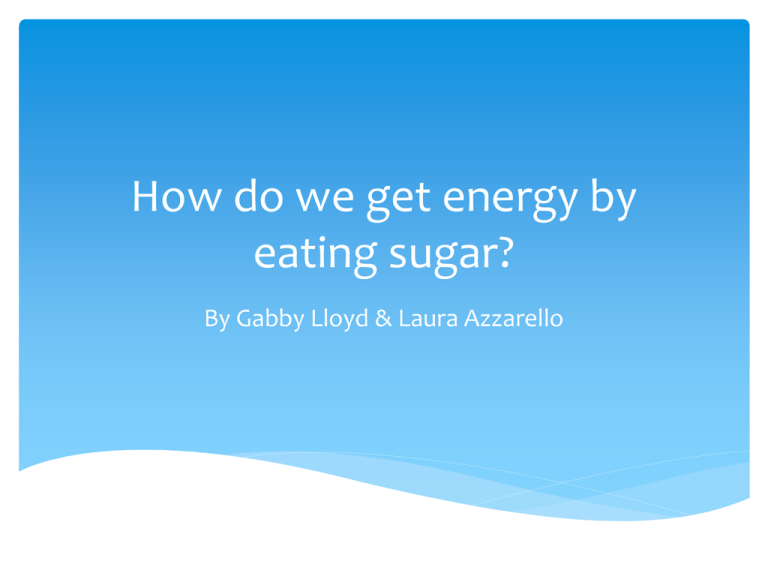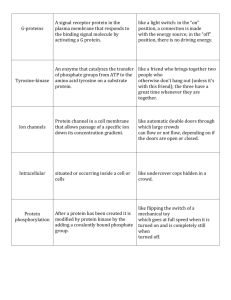How do we get energy by eating sugar?
advertisement

How do we get energy by eating sugar? By Gabby Lloyd & Laura Azzarello What is Glycolysis? Definition: The breakdown of glucose by enzymes, releasing energy and pyruvic acid. Glucose (from the food you eat) travels in the blood through your arteries, enters a cell along the way, and then glycolysis occurs turning glucose into pyruvic acid + energy for your cell. Products of Glycolysis Formula Full Name Nomenclature C6H12O6 Glucose Covalent ATP Adenosine Triphosphate Covalent ADP Adenosine Diphosphate Covalent Pi Inorganic Phosphates High Energy Phosphate Bond NAD+ Nicotinamide adenine dinucleotide Compound = glucose + 2ATP + 4ADP + 2Pi +2NAD+ What is glucose? Glucose : Equation: C6H12O6 It is a simple form of sugar from plants, it is absorbed directly into the bloodstream along with fructose and galactose. Our cells use it as an important from of energy It is a main product in photosynthesis and cellular respiration Reactants of Glycolysis Formula Full Name Nomenclature CH3COCOOH Pyruvic Acid Covalent ADP Adenosine Diphosphate Covalent ATP Adenosine Triphosphate Covalent NADH Nicotinamide adenine dinucleotide Compound H Hydrogen Atomic H20 Water Covalent = 2pyruvic acid + 2ADP + 4ATP + 2NADH + 2H+ +2H2O What is pyruvic acid? Pyruvic Acid Equation: CH3COCOOH What is created from glucose after the process of glycolysis It is an organic acid formed It supplies energy to cells through the kerbs cycle Chemical Equation Glycolysis : C6H12O6 + 2ATP + 4ADP + 2Pi +2NAD+ CH3COCOOH + 2ADP + 4ATP + 2NADH + 2H+ +2H2O Skeleton Equation: Glucose + Adenosine Triphosphate + Adenosine Diphosphate + inorganic phosphates + Nicotinamide adenine dinucleotide Glucose + Adenosine Diphosphate + Adenosine Triphosphate + Nicotinamide adenine dinucleotide + Hydrogen + Water 10 steps of Glycolysis For each step there is a different type of reaction Some examples of chemical reactions we see are: Phosphate Ester Synthesis Isomerization Oxidation Hydrolysis of Phosphate; Synthesis of ATP Alcohol Dehydration Phosphate Ester Hydrolysis; Synthesis of ATP Phosphate Ester Synthesis Step 1: Glycolysis starts when a glucose molecule Attaches itself to an ATP molecule, forming Glucose-6phosphate. This destabilizes the glucose so it can not resist from future changes. Isomerization Step 2: Glucose 6-phosphate is reorganized to form Fructose 6-phosphate. Phosphate Ester Synthesis Step 3: Then another phosphate group attaches itself as well, to form Fructose 1,6-diphosphate. This occurs also to destabilize the glucose molecule. Split Molecule in half Step 4: Fructose 1,6-diphosphate is split into dihydroxyacetone phosphate and glyceraldehyde phosphate Isomerization Step 5: Glyceraldehydes phosphate will be consumed in the following steps there for step 5 is a continuous reaction where dihydroxyacetone phosphate is converted to glyceraldehyde phosphate as needed by the cell. Oxidation/Phosphate Ester Synthesis Step 6: Hydrogen atoms accompanied by their electrons are removed from the glyceraldehyde phosphate molecules - a process known as oxidation. The two hydrogen atoms and electrons reduce NAD+ to NADH which then carries the electrons in an electron transport chain. In addition, a phosphate group is attached to the 1 position of the molecule forming two molecules of 1,3-diphosphoglycerate Hydrolysis of Phosphate; Synthesis of ATP Step 7: The phosphate added to the first molecule is removed and added to the ADP molecule in order to form the ATP molecule. There are now 2 molecules that are involved. The remaining molecules at the end of this step are 3-phosphoglyceric acid molecules. Isomerization Step 8: The phosphate group that was previously in the third position is placed in the second position with the aid of an enzyme Alcohol Dehydration Step 9: A water molecule is removed from the structure leaving phosphoenolpyruvic acid. As can be seen in the picture, the removal of the water causes the energy of the molecule to now be situated in the center instead of the outside. Phosphate Ester Hydrolysis; Synthesis of ATP Step 10: The remaining phosphate group is attached to an ADP forming a ATP molecule similar to step 7. Therefore, the net gain of glycolysis is two ATP molecules per molecule of glucose. Two molecules of pyruvic acid are the remaining products of the complex process of glycolysis. Scientific Community Gustav Embden Otto Meyerhof Jakub Parnas These 3 scientist each played a role in the formation and understanding of glycolysis. Questions? Thank you!





